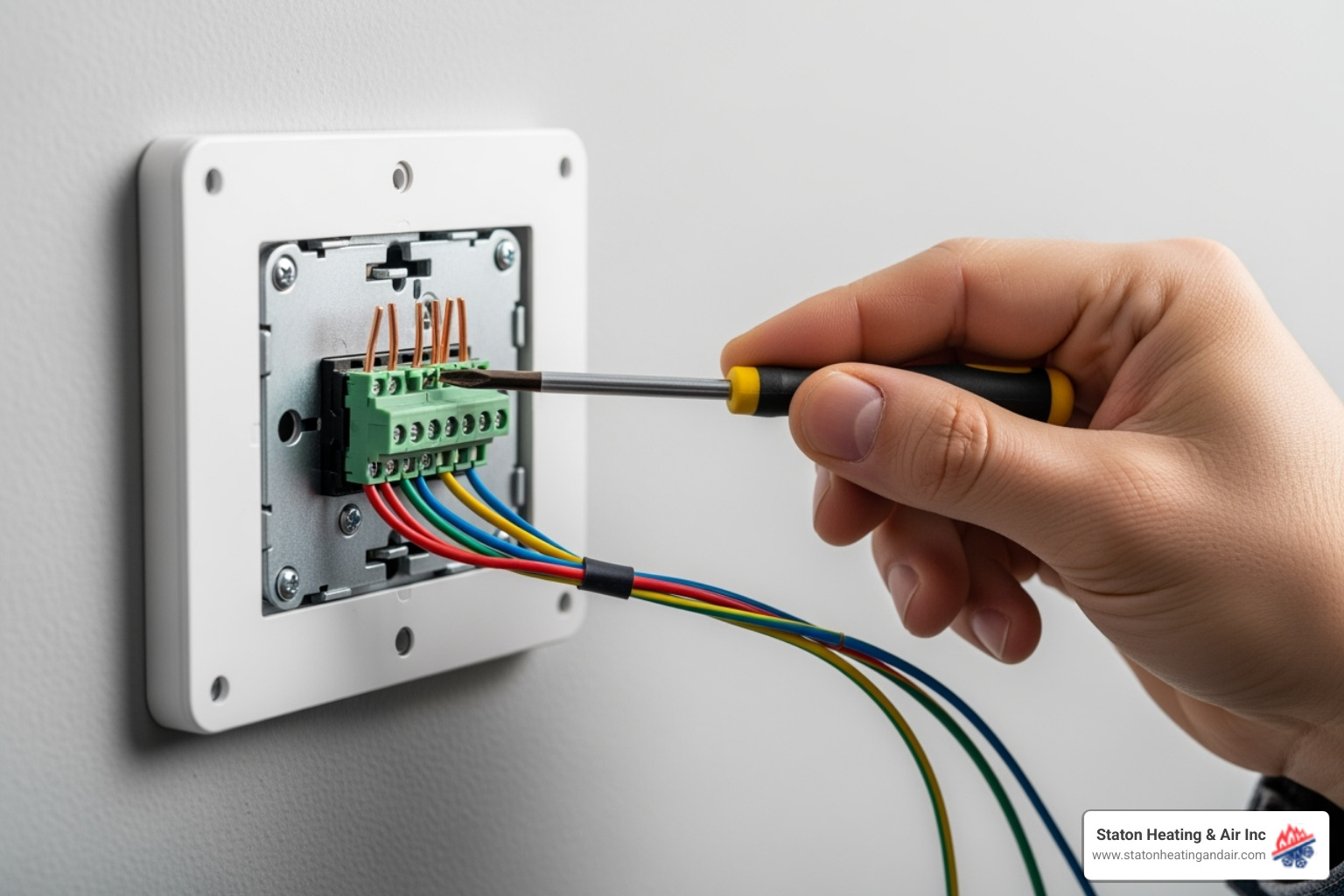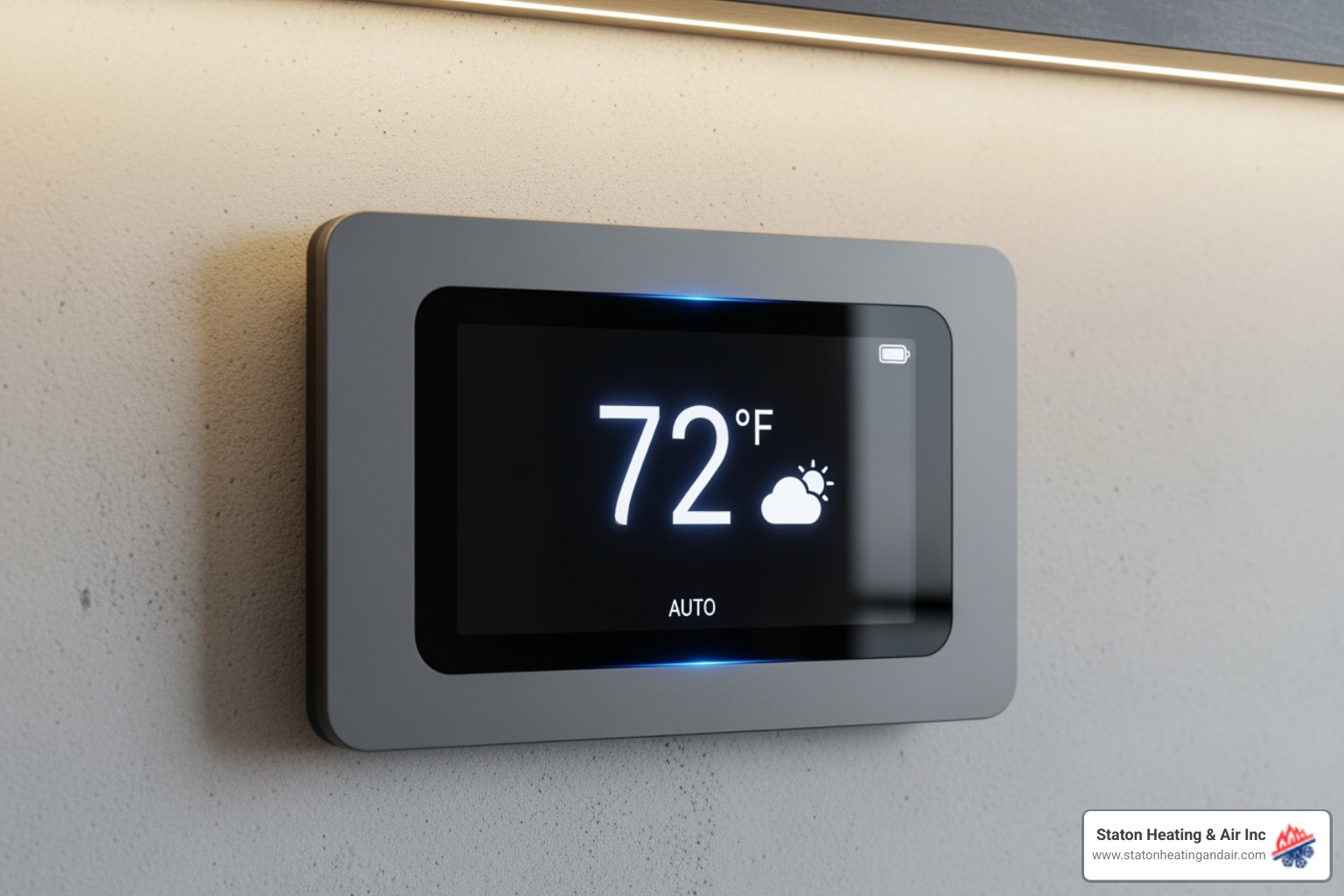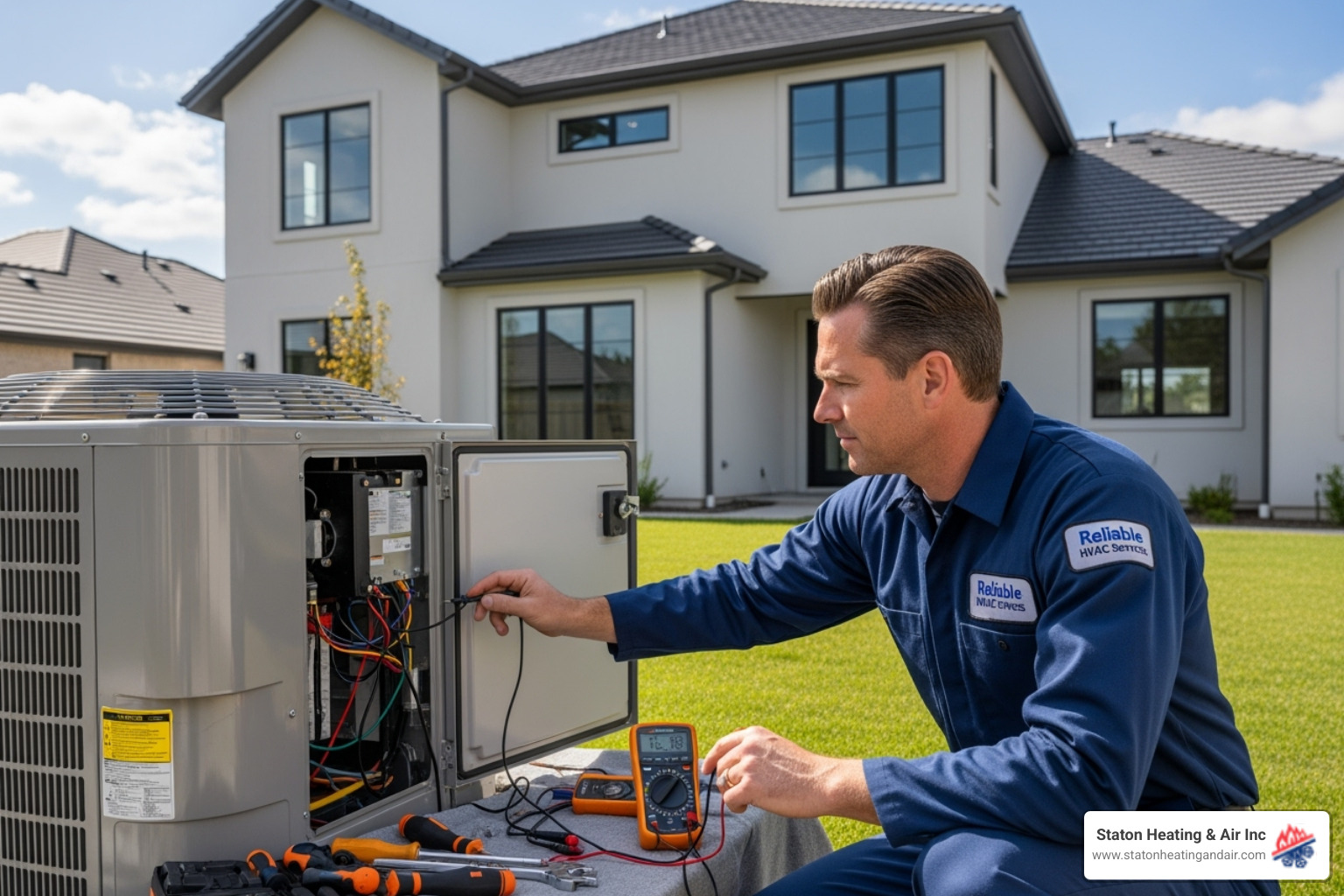From Air to Awesome: A How-To for Your High-Efficiency Heat Pump Setup
Why Professional Air to Air Heat Pump Installation Matters
Air to air heat pump installation is a multi-step process that moves heat between your home and outdoor air for both heating and cooling. Here's what it involves:
The Core Installation Steps:
- Site Assessment - Evaluating your home's insulation, electrical capacity, and space requirements
- System Selection - Choosing the right size and configuration (ducted or ductless)
- Outdoor Unit Setup - Installing the condenser on a level pad or wall brackets
- Indoor Unit Installation - Mounting air handlers or connecting to existing ductwork
- System Connection - Running refrigerant lines, electrical wiring, and condensate drains
- Commissioning - Pressure testing, evacuating lines, and charging refrigerant
- Final Testing - Verifying proper operation and homeowner orientation
Timeline: Most installations take 1-5 days depending on system complexity and home configuration.
Between 50% and 90% of heat pumps are installed incorrectly, according to research from the HVAC industry. That's a staggering number that can lead to higher energy bills, uncomfortable temperatures, and expensive repairs down the road.
The good news? When done right, air-to-air heat pumps deliver exceptional efficiency—up to two to four times more heat energy than the electrical energy they consume. They're also quieter and more environmentally friendly than traditional heating systems.
But here's the catch: heat pumps are more finicky than furnaces or air conditioners. They require specialized knowledge, precise refrigerant handling, and careful attention to details like ductwork sizing and electrical connections. That's why choosing an experienced, certified installer isn't just recommended—it's essential.
In this guide, we'll walk you through everything you need to know about the installation process, from preparing your home to understanding what happens on installation day. Whether you're replacing an old system or adding climate control to a new space, you'll know exactly what to expect.
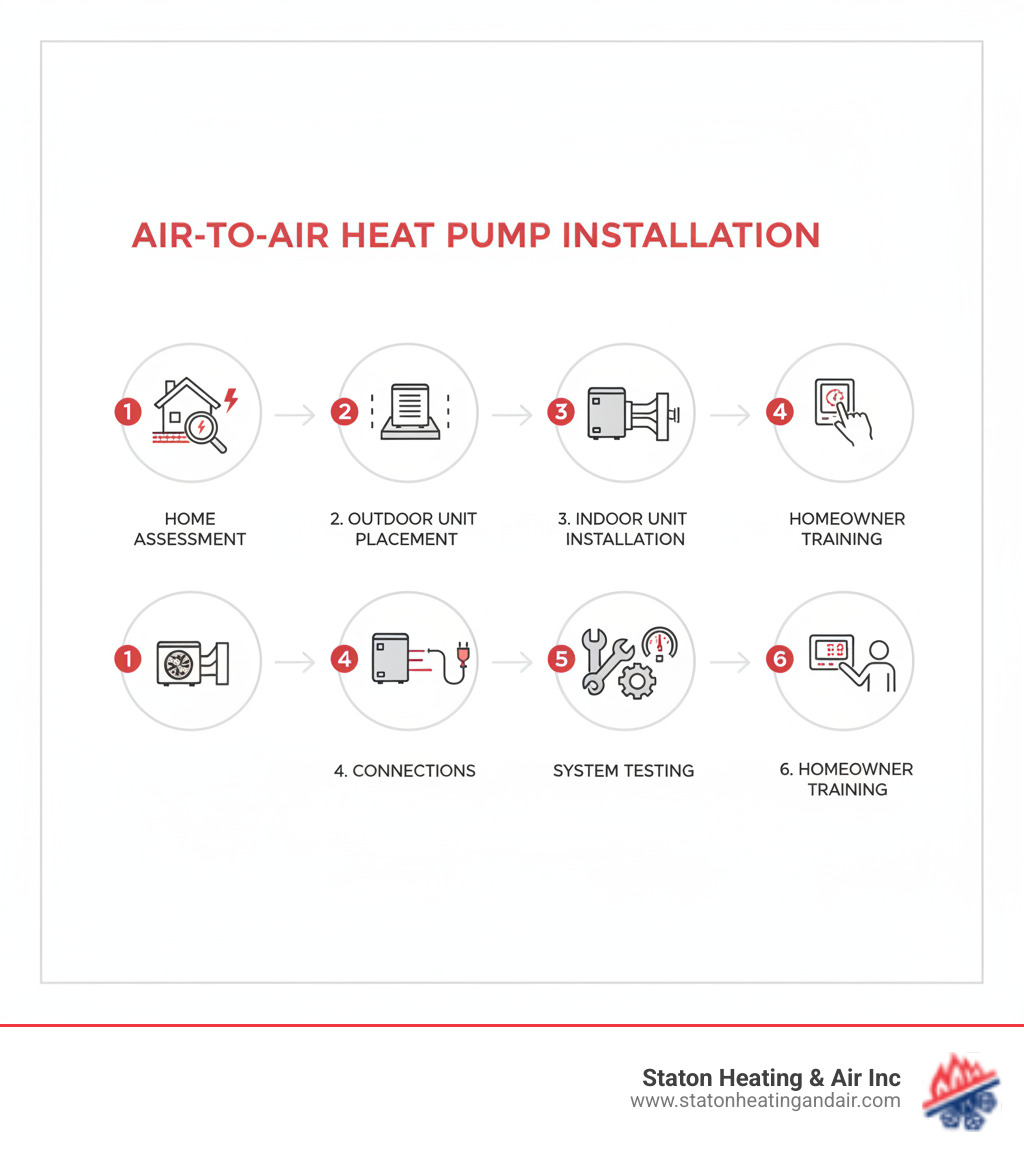
Understanding Your Air-to-Air Heat Pump
An air-to-air heat pump is a versatile climate control system. Instead of creating heat like a furnace, it moves it. In winter, it pulls warmth from the outdoor air to bring inside. In summer, it reverses the process, moving heat from your home to the outdoors for cooling.
How it works:
In heating mode, the outdoor unit absorbs heat energy from the air and transfers it to a refrigerant. This refrigerant is compressed, raising its temperature, and then circulated indoors to release warmth. In cooling mode, the process reverses: the indoor unit absorbs heat from your home's air, and the outdoor unit releases it outside. A component called the reversing valve makes this two-way operation possible.
Main components:
A heat pump system consists of an outdoor condenser unit (housing the compressor, a coil, and a fan) and an indoor air handler unit. For ducted systems, the air handler connects to your home's ductwork. For ductless systems, you'll have individual wall-mounted units. Insulated copper refrigerant lines connect the two units, allowing the refrigerant to carry heat back and forth.
Benefits:
The primary benefit of a heat pump is its high efficiency. Since it moves heat rather than generating it, it can deliver two to four times more heat energy than the electricity it consumes. This leads to lower energy bills and a reduced carbon footprint, as it's an all-electric system that moves you away from fossil fuels.
Today's heat pumps offer incredible modern performance, thanks to variable-speed compressors and improved designs that work well even in cold weather. Look for the latest efficiency standards: the HSPF2 rating for heating and the SEER2 rating for cooling. These 2023 standards better reflect real-world performance. You can learn about efficiency ratings on the ENERGY STAR® website to understand these ratings.
System Configurations: Ducted vs. Ductless
When planning your air to air heat pump installation, you'll choose between two main configurations.
Ducted systems use a central air handler connected to your home's ductwork to distribute conditioned air. If you have a furnace or central AC, a ducted heat pump can often use the existing ducts, provided they are properly sized and in good condition. This setup also allows for whole-home air filtration.
Ductless mini-splits use individual indoor units (wall-mounted units) to condition specific rooms or zones, making them ideal for homes without ductwork, for additions, or for creating zoned comfort. A single-zone system pairs one outdoor unit with one indoor unit for a single space. A multi-zone system connects one outdoor unit to multiple indoor units, allowing for independent temperature control in different rooms. This avoids potential energy loss from ductwork and requires minimal construction.
The Pre-Installation Checklist: Preparing Your Home
Before our NATE-certified technicians arrive for your air to air heat pump installation, some important groundwork ensures your home is ready for this high-efficiency system.
Home assessment:
We start by assessing your home's "thermal envelope" to ensure efficiency. This includes checking insulation levels in the attic and walls, window quality (double-glazed is best), and performing air sealing to eliminate drafts around doors and windows. A well-sealed and insulated home allows your heat pump to work most effectively, preventing energy waste and potentially allowing for a smaller system.
System sizing:
Proper system sizing is critical. A system that's too large will cycle inefficiently, while one that's too small won't keep you comfortable. We perform a detailed Manual J load calculation, which considers your home's size, layout, insulation, window types, and local climate to determine the exact size your home needs. This scientific approach ensures optimal performance.
Outdoor unit placement:
Where the outdoor unit is placed matters. It needs at least 3 feet of airflow clearance on all sides to operate efficiently. We also consider noise, placing the unit away from bedroom windows or outdoor living areas when possible. The unit must be installed on a level pad or risers to keep it clear of debris and potential snow accumulation.
Electrical requirements:
Heat pumps have specific electrical requirements. Your new system will need its own dedicated circuit to ensure consistent power. We'll also assess your home's main electrical panel capacity to confirm it can handle the load. Some older homes may need a service upgrade, which our qualified electricians can handle to ensure safe and reliable operation.
Key Considerations for Your Air to Air Heat Pump Installation
Choosing a qualified installer is the single most important factor for a successful installation. Heat pumps are more complex than traditional HVAC systems and require specialized knowledge.
Look for NATE-certified technicians, as NATE (North American Technician Excellence) is the industry's gold standard for expertise. Ensure your contractor is fully licensed and insured to protect you and your home. Local experience is also vital; a contractor familiar with the Metro Atlanta climate, like Staton Heating & Air Inc. (serving the area since 1972), understands how to optimize systems for our hot summers and occasional cold snaps. Don't hesitate to verifying credentials and check reviews. You can also find technicians recognized by the DOE's Energy Skilled Programs. At Staton Heating & Air Inc., our NATE-certified team ensures your air to air heat pump installation is done right, living up to our motto: "Where customers come first!"
The Step-by-Step Air to Air Heat Pump Installation Process
Once planning is complete, our team at Staton Heating & Air Inc. follows a meticulous process to ensure your air to air heat pump installation is seamless and delivers optimal performance.
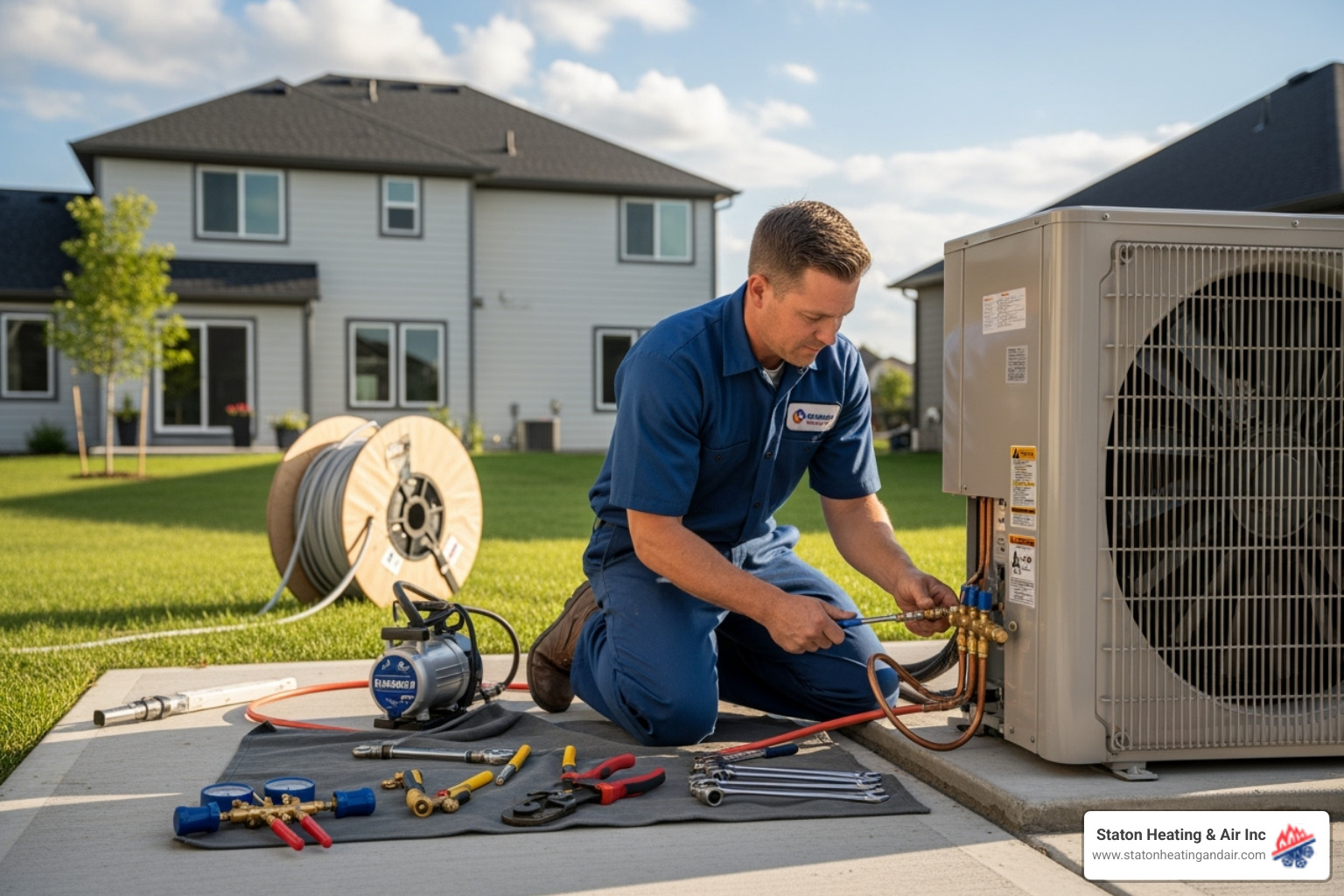
Installation day begins with site preparation. We ask you to clear the work areas, and our crew lays down protective coverings to keep your home clean. We then conduct a final homeowner walkthrough to confirm placement details and answer any last-minute questions. If you're replacing a system, our next step is removing old equipment. We safely disconnect and haul away your old unit, ensuring any refrigerants are disposed of according to environmental regulations.
Next, we perform the outdoor and indoor unit installation. The outdoor condenser is secured on a prepared level pad or wall brackets, ensuring proper clearance for airflow. Inside, the new air handler is connected to your ductwork (for ducted systems), or sleek wall-mounted units are installed in their designated zones (for ductless systems). We ensure all connections are airtight to maximize efficiency.
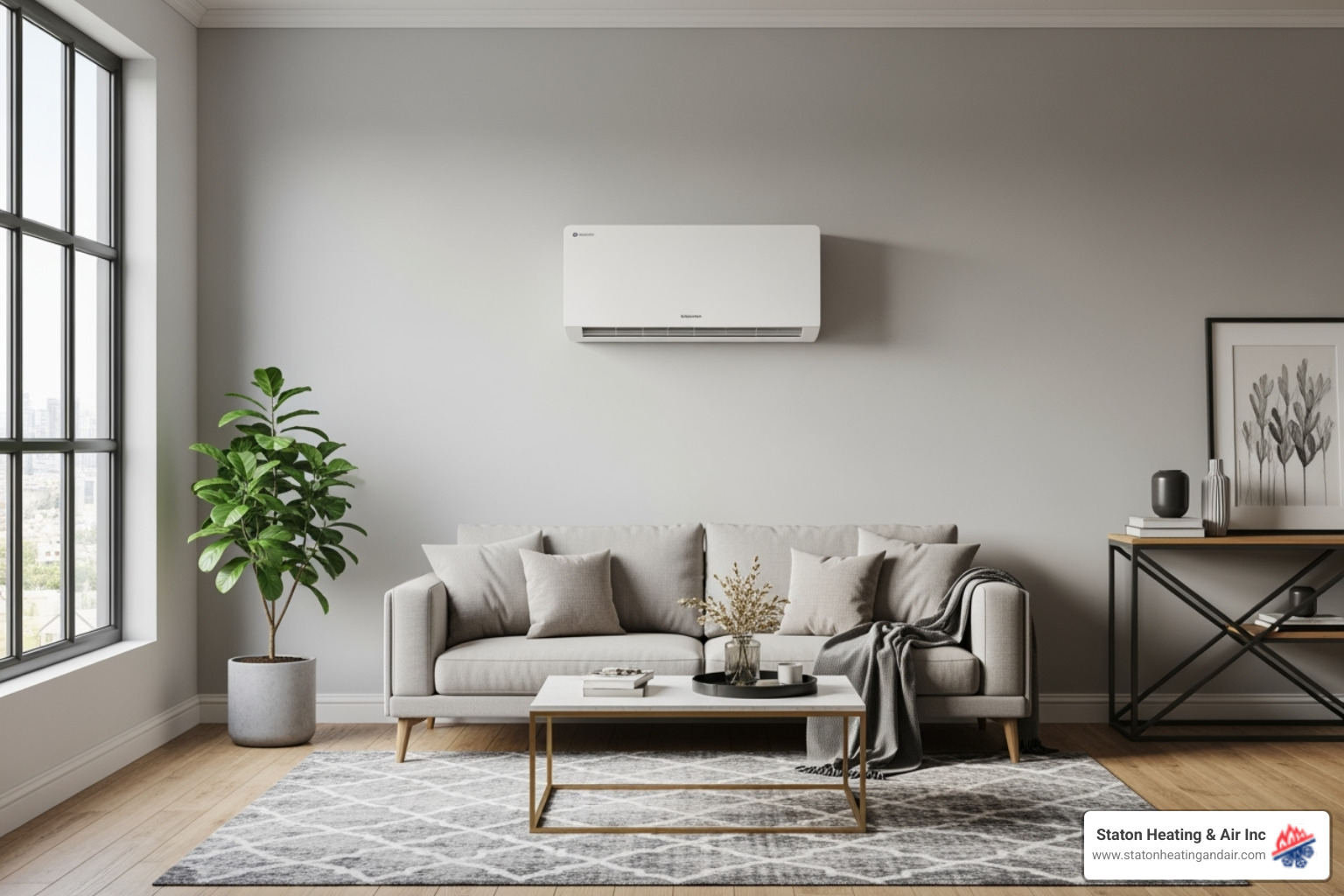
The most technical phase is connecting the system. This involves drilling a small, sealed opening to run the refrigerant lines, electrical wiring, and a condensate drain between the indoor and outdoor units. Our qualified electricians connect the heat pump to its dedicated circuit, following all safety codes. We recommend a surge suppressor to protect your system's sensitive electronics.
With the system connected, we begin system commissioning—a critical step that ensures longevity and performance. We perform a pressure test with nitrogen to check for leaks. Then, we use a vacuum pump to evacuate all air and moisture from the refrigerant lines, a non-negotiable step for preventing internal corrosion. Finally, we perform a precise refrigerant charge, adding the exact amount specified by the manufacturer, as an incorrect charge can reduce efficiency by up to 20%.
During final checks, we run the system in both heating and cooling modes to verify temperatures, airflow, and thermostat control. The typical timeline for an air to air heat pump installation is 1-2 days for simpler systems and up to 5 days for complex installations. We'll provide a clear timeline upfront.
Post-Installation: Maximizing Performance and Longevity
Congratulations on your new air to air heat pump installation! Getting the most out of your investment requires a bit of understanding and simple ongoing care.
User orientation:
Before we leave, we provide a thorough user orientation. We'll walk you through your new thermostat and system controls, ensuring you feel confident operating your heat pump for maximum comfort and efficiency. We're happy to answer all your questions.
Avoiding problems:
Common performance issues like poor airflow (often from dirty filters) or an incorrect refrigerant charge (due to a leak) can reduce efficiency. The best way to avoid these problems is to start with a professional installation from NATE-certified technicians and commit to regular maintenance. A proper setup from day one is the key to long-term, reliable performance.
Maintenance After Your Air to Air Heat Pump Installation
Regular care keeps your heat pump in top shape.
Homeowner tasks are simple:
- Check and clean or replace air filters every 1-3 months. A clean filter is essential for good airflow and efficiency.
- Keep the outdoor unit clear of debris. Gently remove leaves, grass, and dirt from the unit and keep vegetation trimmed at least a foot away.
Professional maintenance is also crucial. We recommend annual service checks with our NATE-certified technicians. During a tune-up, we inspect electrical components, check for refrigerant leaks, clean the coils, and verify overall system performance. This preventative care catches small issues early, maximizes efficiency, and can extend your system's lifespan to 15 years or more.
Frequently Asked Questions about Air-to-Air Heat Pumps
Homeowners in Cumming, GA, and Metro Atlanta often have questions about air to air heat pump installation. Here are answers to the most common ones.
How do air-to-air heat pumps perform in Georgia's cold weather?
Modern cold-climate heat pumps are engineered to work efficiently even in freezing temperatures, easily handling a typical Georgia winter. They can extract warmth from outdoor air well below freezing. For the rare, extremely cold days in Metro Atlanta, systems are designed with a supplemental heat source (usually electric resistance coils) that kicks in automatically to ensure your home stays warm. During installation, we optimize the system's "balance point" to use the highly efficient heat pump as much as possible, keeping your energy bills low.
Can I use my existing ductwork for a new heat pump?
Possibly. If your home has ductwork from a furnace or central AC, it might be compatible. However, heat pumps move a larger volume of air than furnaces, so they often require larger ducts. During our assessment for your air to air heat pump installation, we conduct a full ductwork inspection. We check for proper sizing, leaks, and adequate insulation. Leaky or undersized ducts can reduce efficiency by up to 20%. We'll identify any necessary modifications to ensure your new heat pump performs at its peak.
How noisy are modern heat pump systems?
Forget the noisy HVAC units of the past. Modern heat pumps are remarkably quiet, with decibel (dB) ratings often as low as a refrigerator. This is thanks to innovations like variable-speed compressors that run at lower, quieter speeds most of the time, plus sound-dampening cabinets and advanced fan designs. Proper placement also minimizes noise. We strategically locate the outdoor unit away from windows and living spaces to ensure your home remains a peaceful sanctuary.
Conclusion: Enjoy Year-Round Comfort with a Professional Installation
An air-to-air heat pump is a smart investment in your home, offering lower energy bills, a reduced carbon footprint, and consistent, year-round comfort. However, these benefits hinge on one critical factor: a professional installation.
With research showing that a high percentage of heat pumps are installed incorrectly, choosing an expert team is essential. An improper setup can negate energy savings and lead to premature system failure. This is why NATE-certified expertise is non-negotiable for a system that demands precision.
At Staton Heating & Air Inc., we've provided expert HVAC services to Cumming, GA, and Metro Atlanta since 1972. Our NATE-certified technicians ensure every air to air heat pump installation is performed to the highest standards, reflecting our "customers come first!" philosophy and our reputation as 2024's Best HVAC Company in Cumming.
Ready to upgrade to efficient, all-season comfort? Learn more about our professional heat pump services and let our team guide you on your journey from air to awesome.
Recent Posts
What Our Customers Are Saying


Ready to Transform Your Home?

Recent Blog







